Digital-Twin-Based Fire Safety Management Framework for Smart Buildings
Abstract
1. Introduction
- What is the current state of DT adoption for fire emergencies in the FM industry?
- What are the core DT drivers and challenges for a fire emergency?
- Explore the current status of DT implementation in FSE and fire evacuation;
- Develop a DT-based FSM framework towards smart FM;
- Explore the current state of DT adoption for fire emergencies through a survey;
- Explore the technical challenges encountered during DT implementation through a survey.
2. Literature Review
2.1. Current Systems-Based FM
2.2. Digital Twin (DT)
2.3. DT-Enabling Technologies for Fire Safety Management
2.3.1. Building Information Modeling (BIM)
2.3.2. Internet of Things (IoT)
2.3.3. Artificial Intelligence (AI)
2.3.4. Augmented Reality (AR)
2.4. DT Technologies for Smart Building Applications
2.5. Summary of the Literature Review
3. Methodology
3.1. Literature Selection
3.2. Literature Characteristics
3.3. Development of DT-Based FSM Framework toward Smart FM
3.3.1. Physical Building Layer
3.3.2. Virtual Building Layer
3.3.3. Application Layer
3.3.4. User Interaction Layer
3.4. Survey of FM Professionals
4. Results
4.1. Literature Review Findings
4.1.1. Barriers
4.1.2. Enablers
4.2. Survey Results
4.2.1. Demographic Distribution
4.2.2. Level of Familiarity and Understanding with DT Technologies in FM
4.2.3. DTs for FSE Maintenance and Fire Evacuation Benefits
4.2.4. Participants’ Evaluation of DT Framework in FM
5. Discussion
5.1. Main Challenges
5.1.1. Stakeholder-Oriented Barriers
5.1.2. Economic Barriers
5.1.3. Technical Barriers
6. Conclusions
Author Contributions
Funding
Data Availability Statement
Conflicts of Interest
References
- US Fire Administration. U.S. Fire Statistics. Available online: https://www.usfa.fema.gov/statistics/ (accessed on 9 November 2022).
- Deak, G.; Curran, K.; Condell, J. A survey of active and passive indoor localisation systems. Comput. Commun. 2012, 35, 1939–1954. [Google Scholar] [CrossRef]
- Kobes, M.; Helsloot, I.; De Vries, B.; Post, J.G. Building safety and human behaviour in fire: A literature review. Fire Saf. J. 2010, 45, 1–11. [Google Scholar] [CrossRef]
- Zhang, J.; Guo, J.; Xiong, H.; Liu, X.; Zhang, D. A Framework for an Intelligent and Personalized Fire Evacuation Management System. Sensors 2019, 19, 3128. [Google Scholar] [CrossRef] [PubMed]
- Rubadiri, L.; Ndumu, D.T.; Roberts, J.P. Predicting the evacuation capability of mobility-impaired occupants. Fire Technol. 1997, 33, 32–53. [Google Scholar] [CrossRef]
- Binalhaj, M.; Liu, H.; Sulaiman, M.; Abudayyeh, O. Mobile crowdsourcing-based data collection for user-centered facility maintenance management. Can. J. Civ. Eng. 2021, 48, 1652–1662. [Google Scholar] [CrossRef]
- Chen, W.; Chen, K.; Cheng, J.C.; Wang, Q.; Gan, V.J. BIM-based framework for automatic scheduling of facility maintenance work orders. Autom. Constr. 2018, 91, 15–30. [Google Scholar] [CrossRef]
- Chen, Y.-J.; Lai, Y.-S.; Lin, Y.-H. BIM-based augmented reality inspection and maintenance of fire safety equipment. Autom. Constr. 2020, 110, 103341. [Google Scholar] [CrossRef]
- Chen, H.; Hou, L.; Zhang, G.; Moon, S. Development of BIM, IoT and AR/VR Technologies for Fire Safety and Upskilling. Autom. Constr. 2021, 125, 103631. [Google Scholar] [CrossRef]
- Sulaiman, M.; Liu, H.; Binalhaj, M.; Liou, W.W.; Abudayyeh, O. GIS-Based Automatic Flight Planning of Camera-Equipped UAVs for Fire Emergency Response. In Proceedings of the IEEE International Conference on Electro Information Technology 2020, Chicago, IL, USA, 31 July–1 August 2020. [Google Scholar] [CrossRef]
- Kanangkaew, S.; Jokkaw, N.; Tongthong, T. A real-time fire evacuation system based on the integration of building information modeling and augmented reality. J. Build. Eng. 2023, 67, 105883. [Google Scholar] [CrossRef]
- Adjiski, V.; Despodov, Z.; Mirakovski, D.; Mijalkovski, S. Fire risk assessment and computer simulation of fire scenario in underground mines. Stud. Eng. Technol. 2015, 2, 54. [Google Scholar] [CrossRef][Green Version]
- Wang, B.; Li, H.; Rezgui, Y.; Bradley, A.; Ong, H.N. BIM based virtual environment for fire emergency evacuation. Sci. World J. 2014, 2014, 589016. [Google Scholar] [CrossRef] [PubMed]
- Fahy, R.F.; Proulx, G. Toward Creating a Database on Delay Times to Start Evacuation and Walking Speeds for Use in Evacuation Modeling. In Proceedings of the 2nd International Symposium on Human Behaviour in Fire, Boston, MA, USA, 26–28 March 2001; pp. 175–183. [Google Scholar]
- Alsharari, H.; Liou, W.W.; Abudayyeh, O. An Immersive Environment for Building Fire Safety Training. In Proceedings of the CSCE Annual Conference “Growing with youth”, Montreal, QC, Canada, 12–15 June 2019. [Google Scholar]
- Chen, X.-S.; Liu, C.-C.; Wu, I.-C. A BIM-based visualization and warning system for fire rescue. Adv. Eng. Inform. 2018, 37, 42–53. [Google Scholar] [CrossRef]
- Li, N.; Yang, Z.; Ghahramani, A.; Becerik-Gerber, B.; Soibelman, L. Situational awareness for supporting building fire emergency response: Information needs, information sources and implementation requirements. Fire Saf. J. 2014, 63, 17–28. [Google Scholar] [CrossRef]
- Groner, N.; Jennings, C.; Robinson, A. A Negotiated-Text Method for Assessing Situation Awareness Information Requirements from Emergency Responders. In Proceedings of the 2012 IEEE International Multi-Disciplinary Conference on Cognitive Methods in Situation Awareness and Decision Support, New Orleans, LA, USA, 6–8 March 2012; IEEE: Piscataway, NJ, USA, 2012; pp. 259–263. [Google Scholar] [CrossRef]
- Lurz, F.; Mueller, S.; Lindner, S.; Linz, S.; Gardill, M.; Weigel, R.; Koelpin, A. Smart Communication and Relative Localization System for Firefighters and Rescuers. In Proceedings of the IEEE MTT-S International Microwave Symposium (IMS), Honolulo, HI, USA, 4–9 June 2017. [Google Scholar] [CrossRef]
- Harris, M. The Way through the Flames. IEEE Spectr. 2013, 50, 30–35. [Google Scholar] [CrossRef]
- Liu, Z.; Zhang, A.; Wang, W. A framework for an indoor safety management system based on digital twin. Sensors 2020, 20, 5771. [Google Scholar] [CrossRef]
- Khajavi, S.H.; Tetik, M.; Liu, Z.; Korhonen, P.; Holmstrom, J. Digital twin for safety and security: Perspectives on building lifecycle. IEEE Access 2023, 11, 52339–52356. [Google Scholar] [CrossRef]
- Jiang, L.; Shi, J.; Wang, C.; Pan, Z. Intelligent control of building fire protection system using digital twins and semantic web technologies. Autom. Constr. 2023, 147, 104728. [Google Scholar] [CrossRef]
- Zhang, T.; Wang, Z.; Zeng, Y.; Wu, X.; Huang, X. Building artificial-intelligence digital fire (AID-Fire) system: A real-scale demonstration. J. Build. Eng. 2022, 62, 105363. [Google Scholar] [CrossRef]
- Cheng, M.-Y.; Chiu, K.-C.; Hsieh, Y.-M.; Yang, I.T.; Chou, J.-S.; Wu, Y.-W. BIM integrated smart monitoring technique for building fire prevention and disaster relief. Autom. Constr. 2017, 84, 14–30. [Google Scholar] [CrossRef]
- Choi, J.; Choi, J.; Kim, I. Development of BIM-based evacuation regulation checking system for high-rise and complex buildings. Autom. Constr. 2014, 46, 38–49. [Google Scholar] [CrossRef]
- Wehbe, R.; Shahrour, I. A BIM-based smart system for fire evacuation. Future Internet 2021, 13, 221. [Google Scholar] [CrossRef]
- Lewis, A.; Riley, D.; Elmualim, A. Defining high performance buildings for operations and maintenance. Int. J. Facil. Manag. 2010, 1, 1–16. [Google Scholar]
- Alkasisbeh, M.R.; Abudayyeh, O. Building Asset Management System: A Performance Evaluation Approach. In Proceedings of the 2018 IISE Annual Conference, Orlando, FL, USA,, 19–22 May 2018; pp. 2175–2180. [Google Scholar]
- Al-Kasisbeh, M.R.; Abudayyeh, O. Municipality Asset Management: Asset Types and Effective Management Decision Using GIS. In Proceedings of the Construction Research Congress 2018, New Orleans, LA, USA, 2–4 April 2018; pp. 273–280. [Google Scholar]
- Al-Kasasbeh, M.; Abudayyeh, O.; Liu, H. An integrated decision support system for building asset management based on BIM and Work Breakdown Structure. J. Build. Eng. 2021, 34, 101959. [Google Scholar] [CrossRef]
- Al-Kasasbeh, M.; Abudayyeh, O.; Liu, H. A Unified Work Breakdown Structure-Based Framework for Building Asset Management. J. Facil. Manag. 2020, 18, 437–450. [Google Scholar] [CrossRef]
- Shalabi, F.; Turkan, Y. IFC BIM-based facility management approach to optimize data collection for corrective maintenance. J. Perform. Constr. Facil. 2016, 31, 04016081. [Google Scholar] [CrossRef]
- Wong, J.K.W.; Ge, J.; He, S.X. Digitisation in facilities management: A literature review and future research directions. Autom. Constr. 2018, 92, 312–326. [Google Scholar] [CrossRef]
- Parsanezhad, P.; Dimyadi, J. Effective Facility Management and Operations via a BIM-Based Integrated Information System. In Proceedings of the CIB Facilities Management (CFM) 2014 Conference, Copenhagen, Denmark, 21–23 May 2014; p. 8. Available online: http://www.cfm.dtu.dk/english/CIB-Conference (accessed on 10 November 2016).
- Sapp, D. Facilities Operations & Maintenance—An Overview. 2017. Available online: https://www.wbdg.org/facilities-operations-maintenance (accessed on 3 November 2022).
- Villa, V.; Naticchia, B.; Bruno, G.; Aliev, K.; Piantanida, P.; Antonelli, D. Iot Open-Source Architecture for the Maintenance of Building Facilities. Appl. Sci. 2021, 11, 5374. [Google Scholar] [CrossRef]
- Oti, A.; Kurul, E.; Cheung, F.; Tah, J. The utilization of BMS in BIM for facility management. In Proceedings of the CIB World Building Congress, Tampere, Finland, 30 May–3 June 2016. [Google Scholar] [CrossRef]
- Yang, R.; Wang, L. Multi-objective optimization for decision-making of energy and comfort management in building automation and control. Sustain. Cities Soc. 2012, 2, 1–7. [Google Scholar] [CrossRef]
- Zhou, X.; Li, H.; Wang, J.; Zhao, J.; Xie, Q.; Li, L.; Liu, J.; Yu, J. CloudFAS: Cloud-based building fire alarm system using Building Information Modelling. J. Build. Eng. 2022, 53, 104571. [Google Scholar] [CrossRef]
- Motamedi, A.; Hammad, A.; Asen, Y. Knowledge-assisted BIM-based visual analytics for failure root cause detection in facilities management. Autom. Constr. 2014, 43, 73–83. [Google Scholar] [CrossRef]
- Hsu, H.P.; Yu, K.M.; Chine, S.T.; Cheng, S.T.; Lei, M.Y.; Tsai, N. Emergency evacuation base on intelligent digital signage systems. In Proceedings of the 2014 7th International Conference on Ubi-Media Computing and Workshops, Ulaanbaatar, Mongolia, 12–14 July 2014; pp. 243–247. [Google Scholar] [CrossRef]
- Sulaiman, M.; Liu, H.; Binalhaj, M.; Al-Kasasbeh, M.; Abudayyeh, O. ICT-based integrated framework for smart facility management: An industry perspective. J. Facil. Manag. 2021, 19, 652–680. [Google Scholar] [CrossRef]
- Sulaiman, M.; Liu, H.; Bin Alhaj, M.; Abudayyeh, O. UAV Applications in the AEC/FM Industry: A Review. In Canadian Society of Civil Engineering Annual Conference; Springer: Singapore, 2021; pp. 249–259. [Google Scholar]
- Bin Alhaj, M.; Liu, H.; Abudayyeh, O.; Sulaiman, M. Development of a Mobile Application for Occupant-Centric Facility Maintenance Management. In Proceedings of the 2022 IEEE World AI IoT Congress, AIIoT 2022, Seattle, WA, USA, 6–9 June 2022; pp. 323–329. [Google Scholar] [CrossRef]
- Liu, M.; Fang, S.; Dong, H.; Xu, C. Review of digital twin about concepts, technologies, and industrial applications. J. Manuf. Syst. 2020, 58, 346–361. [Google Scholar] [CrossRef]
- Grieves, M.; Vickers, J. Digital Twin: Mitigating Unpredictable, Undesirable Emergent Behavior in Complex Systems. In Transdisciplinary Perspectives on Complex Systems; Springer: Cham, Switzerland, 2016; pp. 85–113. [Google Scholar] [CrossRef]
- Lu, Q.; Parlikad, A.K.; Woodall, P.; Don Ranasinghe, G.; Xie, X.; Liang, Z.; Konstantinou, E.; Heaton, J.; Schooling, J. Developing a Digital Twin at Building and City Levels: Case Study of West Cambridge Campus. J. Manag. Eng. 2020, 36, 05020004. [Google Scholar] [CrossRef]
- National Institute Building Sciences National BIM Guide for Owners. Nibs 2017, 38, 1–37. Available online: https://www.nibs.org/files/pdfs/NIBS_BIMC_NationalBIMGuide.pdf (accessed on 3 November 2022).
- Mousharbash, N.; Carbonari, A.; Giretti, A.; Turk, Ž. Current Research, Trends, and Challenges in Building Emergency Management. In Proceedings of the 2022 European Conference on Computing in Construction, Ixia, Rhodes, Greece, 24–26 July 2022. [Google Scholar] [CrossRef]
- Shokouhi, M.; Nasiriani, K.; Cheraghi, Z.; Ardalan, A.; Khankeh, H.; Fallahzadeh, H. Preventive measures for fire-related injuries and their risk factors in residential buildings: A systematic review. J. Inj. Violence Res. 2019, 11, 1–14. [Google Scholar] [CrossRef] [PubMed]
- Sabbaghzadeh, M.; Sheikhkhoshkar, M.; Talebi, S.; Rezazadeh, M.; Rastegar Moghaddam, M.; Khanzadi, M. A BIM-Based Solution for the Optimisation of Fire Safety Measures in the Building Design. Sustainability 2022, 14, 1626. [Google Scholar] [CrossRef]
- Yang, Y.; Sun, Y.; Chen, M.; Zhou, Y.; Wang, R.; Liu, Z. Platform development of BIM-based fire safety management system considering the construction site. Buildings 2022, 8, 1268. [Google Scholar] [CrossRef]
- Wang, S.-H.; Wang, W.-C.; Wang, K.-C.; Shih, S.-Y. Applying building information modeling to support fire safety management. Autom. Constr. 2015, 59, 158–167. [Google Scholar] [CrossRef]
- Ma, G.; Wu, Z. BIM-based building fire emergency management: Combining building users’ behavior decisions. Autom. Constr. 2020, 109, 102975. [Google Scholar] [CrossRef]
- Tang, S.; Shelden, D.R.; Eastman, C.M.; Pishdad-Bozorgi, P.; Gao, X. A review of building information modeling (BIM) and the internet of things (IoT) devices integration: Present status and future trends. Autom. Constr. 2019, 101, 127–139. [Google Scholar] [CrossRef]
- Asghari, P.; Rahmani, A.M.; Javadi, H.H.S. Internet of Things applications: A systematic review. Comput. Netw. 2019, 148, 241–261. [Google Scholar] [CrossRef]
- Li, N.; Becerik-Gerber, B.; Krishnamachari, B.; Soibelman, L. A BIM Centered Indoor Localization Algorithm to Support Building Fire Emergency Response Operations. Autom. Constr. 2014, 42, 78–89. [Google Scholar] [CrossRef]
- Cho, J.; Lee, G.; Lee, S. An automated direction setting algorithm for a smart exit sign. Autom. Constr. 2015, 59, 139–148. [Google Scholar] [CrossRef]
- Chen, A.Y.; Chu, J.C. TDVRP and BIM integrated approach for in-building emergency rescue routing. J. Comput. Civ. Eng. 2016, 30, C4015003. [Google Scholar] [CrossRef]
- Eftekharirad, R.; Nik-Bakht, M.; Hammad, A. Extending IFC for Fire Emergency Real-Time Management Using Sensors and Occupant Information. In Proceedings of the 35th International Symposium on Automation and Robotics in Construction (ISARC 2018), Berlin, Germany, 20–25 July 2018; pp. 985–992. [Google Scholar] [CrossRef]
- Cheung, W.F.; Lin, T.H.; Lin, Y.C. A real-time construction safety monitoring system for hazardous gas integrating wireless sensor network and building information modeling technologies. Sensors 2018, 18, 436. [Google Scholar] [CrossRef]
- McCarthy, J. The inversion of functions defined by turing machines. In Automata Studies. (AM-34); Shannon, C.E., McCarthy, J., Eds.; Annals of Mathematical Studies; Princeton University Press: Princeton, NJ, USA, 1956; Volume 34, pp. 177–181. [Google Scholar]
- Darko, A.; Chan, A.P.C.; Adabre, M.A.; Edwards, D.J.; Hosseini, M.R.; Ameyaw, E.E. Artificial intelligence in the AEC industry: Scientometric analysis and visualization of research activities. Autom. Constr. 2020, 112, 103081. [Google Scholar] [CrossRef]
- Naser, M.Z. Mechanistically informed machine learning and artificial intelligence in fire engineering and sciences. Fire Technol. 2021, 57, 2741–2784. [Google Scholar] [CrossRef]
- Huang, X.; Wu, X.; Usmani, A. Perspectives of using artificial intelligence in building fire safety. In Handbook of Cognitive and Autonomous Systems for Fire Resilient Infrastructures; Naser, M.Z., Corbett, G., Eds.; Springer: New York, NY, USA, 2022; Volume 34, pp. 139–159. [Google Scholar]
- Lee, E.W.M.; Yuen, R.K.K.; Lo, S.M.; Lam, K.C.; Yeoh, G.H. A novel artificial neural network fire model for prediction of thermal interface location in single compartment fire. Fire Saf. J. 2004, 39, 67–87. [Google Scholar] [CrossRef]
- Wang, Z.; Zhang, T.; Wu, X.; Huang, X. Predicting transient building fire based on external smoke images and deep learning. J. Build. Eng. 2022, 47, 103823. [Google Scholar] [CrossRef]
- Wang, Z.; Zhang, T.; Huang, X. Predicting real-time fire heat release rate by flame images and deep learning. Proc. Combust. Inst. 2023, 39, 4115–4123. [Google Scholar] [CrossRef]
- Wang, J.; Tam, W.C.; Jia, Y.; Peacock, R.; Reneke, P.; Fu, E.Y.; Cleary, T. P-flash–a machine learning-based model for flashover prediction using recovered temperature data. Fire Saf. J. 2021, 122, 103341. [Google Scholar] [CrossRef] [PubMed]
- Kou, L.; Wang, X.; Guo, X.; Zhu, J.; Zhang, H. Deep learning based inverse model for building fire source location and intensity estimation. Fire Saf. J. 2021, 121, 103310. [Google Scholar] [CrossRef]
- Wu, X.; Park, Y.; Li, A.; Huang, X.; Xiao, F.; Usmani, A. smart detection of fire source in tunnel based on the numerical database and artificial intelligence. Fire Technol. 2021, 57, 657–682. [Google Scholar] [CrossRef]
- Davila Delgado, J.M.; Oyedele, L.; Beach, T.; Demian, P. Augmented and virtual reality in construction: Drivers and limitations for industry adoption. J. Constr. Eng. Manag. 2020, 146, 04020079. [Google Scholar] [CrossRef]
- Volk, R.; Stengel, J.; Schultmann, F. Building Information Modeling (BIM) for existing buildings—Literature review and future needs. Autom. Constr. 2014, 38, 109–127. [Google Scholar] [CrossRef]
- Chen, K.; Chen, W.; Li, C.T.; Cheng, J.C.P. A BIM-based location aware AR collaborative framework for facility maintenance management. J. Inf. Technol. Constr. 2019, 24, 360–380. [Google Scholar]
- Hou, L.; Wang, Y.; Wang, X.; Maynard, N.; Cameron, I.; Zhang, S.; Maynard, Y. Combining photogrammetry and augmented reality towards an integrated facility management system for the oil industry. Proc. IEEE 2014, 102, 204–220. [Google Scholar] [CrossRef]
- Attaran, M.; Celik, B.G. Digital twin: Benefits, use cases, challenges, and opportunities. Decis. Anal. J. 2023, 6, 100165. [Google Scholar] [CrossRef]
- Pan, Y.; Zhang, L. Roles of artificial intelligence in construction engineering and management: A critical review and future trends. Autom. Constr. 2020, 122, 103517. [Google Scholar] [CrossRef]
- Song, Y.; Li, Y. Digital Twin Aided Healthcare Facility Management: A Case Study of Shanghai Tongji Hospital. In Construction Research Congress 2022; American Society of Civil Engineers (ASCE): Reston, VA, USA, 2022; pp. 1145–1155. [Google Scholar]
- Peng, Y.; Zhang, M.; Yu, F.; Xu, J.; Gao, S. Digital Twin hospital buildings: An exemplary case study through continuous lifecycle integration. Adv. Civ. Eng. 2020, 2020, 8846667. [Google Scholar] [CrossRef]
- Hosamo, H.H.; Nielsen, H.K.; Kraniotis, D.; Svennevig, P.R.; Svidt, K. Digital Twin framework for automated fault source detection and prediction for comfort performance evaluation of existing non-residential Norwegian buildings. Energy Build. 2023, 281, 112732. [Google Scholar] [CrossRef]
- Jafari, M.A.; Zaidan, E.; Ghofrani, A.; Mahani, K.; Farzan, F. Improving building energy footprint and asset performance using digital twin technology. In Proceedings of the Computing in Civil Engineering 2021, Orlando, FL, USA, 12–14 September 2021. [Google Scholar]
- Liu, Y.; Jebelli, H. Developing a Web-Based BIM Asset and Facility Management System of Building Digital Twins. In Proceedings of the Computing in Civil Engineering 2021, Orlando, FL, USA, 12–14 September 2021; pp. 811–818. [Google Scholar]
- Moretti, N.; Xie, X.; Garcia, J.M.; Chang, J.; Parlikad, A.K. Federated data modeling for built environment digital twins. J. Comput. Civ. Eng. 2023, 37, 04023013. [Google Scholar] [CrossRef]
- Eneyew, D.D.; Capretz, M.A.M.; Bitsuamlak, G.T. Towards smart building digital twins: BIM and IoT data integration. IEEE Access 2022, 10, 130487–130506. [Google Scholar] [CrossRef]
- Agapaki, E.; Brilakis, I. CLOI: An Automated Benchmark Framework for Generating Geometric Digital Twins of Industrial Facilities. J. Constr. Eng. Manag. 2021, 147, 0002171. [Google Scholar] [CrossRef]
- Cheng, J.C.P.; Chen, W.; Chen, K.; Wang, Q. Data-driven predictive maintenance planning framework for MEP components based on BIM and IoT using machine learning algorithms. Autom. Constr. 2020, 112, 103087. [Google Scholar] [CrossRef]
- Hosamo, H.H.; Svennevig, P.R.; Svidt, K.; Han, D.; Nielsen, H.K. A Digital Twin predictive maintenance framework of air handling units based on automatic fault detection and diagnostics. Energy Build. 2022, 261, 111988. [Google Scholar] [CrossRef]
- Seghezzi, E.; Locatelli, M.; Pellegrini, L.; Pattini, G.; Giuda, G.M.D.; Tagliabue, L.C.; Boella, G. Towards an occupancy-oriented digital twin for facility management: Test campaign and sensors assessment. Appl. Sci. 2021, 11, 3108. [Google Scholar] [CrossRef]
- Madubuike, O.C.; Anumba, C.J. Digital Twin–based health care facilities management. J. Comput. Civ. Eng. 2023, 37, 04022057. [Google Scholar] [CrossRef]
- Ding, Y.; Zhang, Y.; Huang, X. Intelligent emergency digital twin system for monitoring building fire evacuation. J. Build. Eng. 2023, 77, 107416. [Google Scholar] [CrossRef]
- Almatared, M.; Liu, H.X.; Tang, S.X.; Sulaiman, M.; Lei, Z.; Li, H.X. Digital Twin in the Architecture, Engineering, and Construction Industry: A Bibliometric Review. In Proceedings of the Construction Research Congress 2022: Computer Applications, Automation, and Data Analytics, Arlington, VA, USA, 9–12 March 2022; pp. 670–678. [Google Scholar] [CrossRef]
- Siccardi, S.; Villa, V. Trends in Adopting BIM, IoT and DT for Facility Management: A Scientometric Analysis and Keyword Co-Occurrence Network Review. Buildings 2022, 13, 15. [Google Scholar] [CrossRef]
- Hakimi, O.; Liu, H.; Abudayyeh, O. Digital twin-enabled smart facility management: A bibliometric review. Front. Eng. Manag. 2023, 1–18. [Google Scholar] [CrossRef]
- Liu, H.; Abudayyeh, O.; Liou, W. BIM-Based Smart Facility Management: A Review of Present Research Status, Challenges, and Future Needs. In Proceedings of the Construction Research Congress 2020, American Society of Civil Engineers, Tempe, AZ, USA, 8–10 March 2020; pp. 1087–1095. [Google Scholar]
- Olimat, H.; Liu, H.; Abudayyeh, O. Enabling technologies and recent advancements of smart facility management. Buildings 2023, 13, 1488. [Google Scholar] [CrossRef]
- Liu, R.; Issa, R. Survey: Common knowledge in BIM for facility maintenance. J. Perform. Constr. Facil. 2015, 30, 04015033. [Google Scholar] [CrossRef]
- Dixit, M.K.; Venkatraj, V.; Ostadalimakhmalbaf, M.; Pariafsai, F.; Lavy, S. Integration of facility management and building information modeling (BIM): A review of key issues and challenges. Facilities 2019, 37, 455–483. [Google Scholar] [CrossRef]
- Meng, X.; Minogue, M. Performance measurement models in facility management: A comparative study. Facilities 2011, 29, 472–484. [Google Scholar] [CrossRef]
- Hakimi, O.; Liu, H.; Abudayyeh, O.; Houshyar, A.; Almatared, M.; Alhawiti, A. Data fusion for smart civil infrastructure management: A conceptual digital twin framework. Buildings 2023, 13, 2725. [Google Scholar] [CrossRef]
- Khallaf, R.; Khallaf, L.; Anumba, C.J.; Madubuike, O.C. Review of Digital Twins for Constructed Facilities. Buildings 2022, 12, 2029. [Google Scholar] [CrossRef]
- Lu, Q.; Xie, X.; Parlikad, A.K.; Schooling, J.M. Digital Twin-Enabled Anomaly Detection for Built Asset Monitoring in Operation and Maintenance. Autom. Constr. 2020, 118, 103277. [Google Scholar] [CrossRef]
- Sadri, H.; Yitmen, I.; Tagliabue, L.C.; Westphal, F.; Tezel, A.; Taheri, A.; Sibenik, G. Integration of blockchain and digital twins in the smart built environment adopting disruptive technologies—A systematic review. Sustainability 2023, 15, 3713. [Google Scholar] [CrossRef]
- Damaševičius, R.; Bacanin, N.; Misra, S. From Sensors to Safety: Internet of Emergency Services (IoES) for Emergency Response and Disaster Management. J. Sens. Actuator Netw. 2023, 12, 41. [Google Scholar] [CrossRef]
- Bhawana; Kumar, S.; Rathore, R.S.; Mahmud, M.; Kaiwartya, O.; Lloret, J. BEST—Blockchain-Enabled Secure and Trusted Public Emergency Services for Smart Cities Environment. Sensors 2022, 22, 5733. [Google Scholar] [CrossRef] [PubMed]
- Bhawana; Kumar, S.; Dohare, U.; Kaiwartya, O. FLAME: Trusted Fire Brigade Service and Insurance Claim System Using Blockchain for Enterprises. IEEE Trans. Ind. Inform. 2023, 19, 7517–7527. [Google Scholar] [CrossRef]
- Choo, K.K.R.; Gai, K.; Chiaraviglio, L. Blockchain-Enabled Secure Communications in Smart Cities. J. Parallel Distrib. Comput. 2021, 152, 125–127. [Google Scholar] [CrossRef]
- Li, D.; Hu, Y.; Lan, M. IoT Device Location Information Storage System Based on Blockchain. Future Gener. Comput. Syst. 2020, 109, 95–102. [Google Scholar] [CrossRef]
- Khana, N.; Leea, D.; Alia, A.K.; Parka, C. Artificial Intelligence and Blockchain-based Inspection Data Recording System for Portable Firefighting Equipment. In Proceedings of the International Symposium on Automation and Robotics in Construction, Kitakyushu, Japan, 27–28 October 2020; pp. 941–947. [Google Scholar]
- Liu, H.; Han, S.; Zhu, Z. Blockchain Technology toward Smart Construction: Review and Future Directions. J. Constr. Eng. Manag. 2023, 149, 03123002. [Google Scholar] [CrossRef]
- Zheng, R.; Jiang, J.; Hao, X.; Ren, W.; Xiong, F.; Ren, Y. bcBIM: A blockchain-based big data model for BIM modification audit and provenance in mobile cloud. Math. Probl. Eng. 2019, 2019, 5349538. [Google Scholar] [CrossRef]
- Suliyanti, W.N.; Sari, R.F. Blockchain-based implementation of building information modeling information using hyperledger composer. Sustainability 2021, 13, 321. [Google Scholar] [CrossRef]
- Siountri, K.; Skondras, E.; Vergados, D.D. Towards a Smart Museum Using BIM, IoT, Blockchain and Advanced Digital Technologies. In Proceedings of the ACM International Conference Proceeding Series, Association for Computing Machinery, New York, NY, USA, 26–28 August 2019. [Google Scholar] [CrossRef]
- Huang, X.; Liu, Y.; Huang, L.; Onstein, E.; Merschbrock, C. BIM and IoT data fusion: The data process model perspective. Autom Constr. 2023, 149, 104792. [Google Scholar] [CrossRef]
- McArthur, J.J.; Shahbazi, N.; Fok, R.; Raghubar, C.; Bortoluzzi, B.; An, A. Machine learning and BIM visualization for maintenance issue classification and enhanced data collection. Adv. Eng. Inform. 2018, 38, 101–112. [Google Scholar] [CrossRef]
- Raghubar, C.; Shahbazi, N.; Bortoluzzi, B.; An, A.; McArthur, J.J. Integrating Visual Analytics and Machine Learning into BIM-Enabled Facilities Management. In Proceedings of the Joint Conference on Computing in Construction (JC3), Heraklion, Greece, 4–7 July 2017; Volume 1, pp. 113–120. [Google Scholar] [CrossRef]
- Wang, C.; Wood, L.C.; Li, H.; Aw, Z.; Keshavarzsaleh, A. Applied Artificial Bee Colony Optimization Algorithm in Fire Evacuation Routing System. J. Appl. Math. 2018, 2018, 7962952. [Google Scholar] [CrossRef]
- Chetehouna, K.; El Tabach, E.; Bouazaoui, L.; Gascoin, N. Predicting the Flame Characteristics and Rate of Spread in Fires Propagating in a Bed of Pinus Pinaster Using Artificial Neural Networks. Process Saf. Environ. Prot. 2015, 98, 50–56. [Google Scholar] [CrossRef]
- Macchi, M.; Roda, I.; Negri, E.; Fumagalli, L. Exploring the role of digital twin for asset lifecycle management. IFAC-PapersOnLine 2018, 51, 790–795. [Google Scholar] [CrossRef]
- Silva, B.N.; Khan, M.; Han, K. Integration of big data analytics embedded smart city architecture with RESTful web of things for efficient service provision and energy management. Future Gener. Comput. Syst. 2020, 107, 975–987. [Google Scholar] [CrossRef]
- Ke, S.; Xiang, F.; Zhang, Z.; Zuo, Y. A enhanced interaction framework based on VR, AR and MR in digital twin. Procedia CIRP 2019, 83, 753–758. [Google Scholar] [CrossRef]
- Yoo, S.J.; Choi, S.H. Indoor AR navigation and emergency evacuation system based on machine learning and IoT technologies. IEEE Internet Things J. 2022, 9, 20853–20868. [Google Scholar] [CrossRef]
- Chen, P.H.; Feng, F. A Fast Flow Control algorithm for real-time emergency evacuation in large indoor areas. Fire Saf. J. 2009, 44, 732–740. [Google Scholar] [CrossRef]
- Tsai, M.K.; Yau, N.J. Enhancing Usability of Augmented-Reality-Based Mobile Escape Guidelines for Radioactive Accidents. J. Environ. Radioact. 2013, 118, 15–20. [Google Scholar] [CrossRef]
- Zhu, Y.; Li, N. Virtual and augmented reality technologies for emergency management in the built environments: A state-of-the-art review. J. Saf. Sci. Resil. 2021, 2, 1–10. [Google Scholar] [CrossRef]
- Cruz, H.; Raheem, A.; Nazarian, S. Computing in Civil Engineering 2021. Proceedings of Computing in Civil Engineering 2020, Digital Twin Technology Applications for Transportation Infrastructure—A Survey-Based Study, Orlando, FL, USA, 12–14 September 2021; pp. 811–818. [Google Scholar]
- Perno, M.; Hvam, L.; Haug, A. Enablers and Barriers to the Implementation of Digital Twins in the Process Industry: A Systematic Literature Review. In Proceedings of the 2020 IEEE International Conference on Industrial Engineering and Engineering Management (IEEM), Singapore, 14–17 September 2020; pp. 959–964. [Google Scholar] [CrossRef]
- Perno, M.; Hvam, L.; Haug, A. Implementation of digital twins in the process industry: A systematic literature review of enablers and barriers. Comput. Ind. 2022, 134, 103558. [Google Scholar] [CrossRef]
- Opoku, D.G.J.; Perera, S.; Osei-Kyei, R.; Rashidi, M.; Bamdad, K.; Famakinwa, T. Barriers to the adoption of digital twin in the construction industry: A literature review. Informatics 2023, 10, 14. [Google Scholar] [CrossRef]
- Hellenborn, B.; Eliasson, O.; Yitmen, I.; Sadri, H. Asset information requirements for blockchain-based digital twins: A data-driven predictive analytics perspective. Smart Sustain. Built Environ. 2023. [Google Scholar] [CrossRef]
- Siebelink, S.; Voordijk, H.; Endedijk, M.; Adriaanse, A. Understanding barriers to bim implementation: Their impact across organizational levels in relation to BIM maturity. Front. Built Environ. 2021, 8, 236–257. [Google Scholar] [CrossRef]
- Mostafa, A.; Alaqeeli, A. Benefits and Challenges of Integrating IoT, VR & AR in the BIM-Based Facility Management Process: Literature and Case-Based Analysis. J. Eng. Res. 2022, 6, 25–40. [Google Scholar] [CrossRef]
- Lu, Q.; Chen, L.; Li, S.; Pitt, M. Semi-automatic geometric digital twinning for existing buildings based on images and CAD drawings. Autom. Constr. 2020, 115, 103183. [Google Scholar] [CrossRef]
- Ozturk, G.B. Digital twin research in the AECO-FM industry. J. Build. Eng. 2021, 40, 102730. [Google Scholar] [CrossRef]
- Rasheed, A.; San, O.; Kvamsdal, T. Digital twin: Values, challenges and enablers from a modeling perspective. IEEE Access 2020, 8, 21980–22012. [Google Scholar] [CrossRef]
- Azhar, S. Building information modeling (BIM): Trends, benefits, risks, and challenges for the AEC industry. Leadersh. Manag. Eng. 2011, 11, 241–252. [Google Scholar] [CrossRef]
- Jiang, A.; Mo, Y.; Kalasapudi, V.S. Status Quo and challenges and future development of fire emergency evacuation research and application in built environment. J. Inf. Technol. Constr. 2022, 27, 781–801. [Google Scholar] [CrossRef]
- Khajavi, S.H.; Motlagh, N.H.; Jaribion, A.; Werner, L.C.; Holmström, J. Digital twin: Vision, benefits, boundaries, and creation for buildings. IEEE Access 2019, 7, 147406–147419. [Google Scholar] [CrossRef]
- Sacks, R.; Brilakis, I.; Pikas, E.; Xie, H.S.; Girolami, M. Construction with digital twin information systems. Data-Centric Eng. 2020, 1, e14. [Google Scholar] [CrossRef]
- Opoku, D.-G.J.; Perera, S.; Osei-Kyei, R.; Rashidi, M. Digital twin application in the construction industry: A literature review. J. Build. Eng. 2021, 40, 102726. [Google Scholar] [CrossRef]
- Pregnolato, M.; Gunner, S.; Voyagaki, E.; De Risi, R.; Carhart, N.; Gavriel, G.; Tully, P.; Tryfonas, T.; Macdonald, J.; Taylor, C. Towards civil engineering 4.0: Concept, workflow and application of digital twins for existing infrastructure. Autom. Constr. 2022, 141, 104421. [Google Scholar] [CrossRef]
- Fuller, A.; Fan, Z.; Day, C.; Barlow, C. Digital twin: Enabling technologies, challenges and open research. IEEE Access 2020, 8, 108952–108971. [Google Scholar] [CrossRef]
- Saporiti, N.; Cannas, V.G.; Pozzi, R.; Rossi, T. Challenges and countermeasures for digital twin implementation in manufacturing plants: A Delphi study. Int. J. Prod. Econ. 2023, 261, 108888. [Google Scholar] [CrossRef]
- Ullah, F.; Sepasgozar, S.M.; Thaheem, M.J.; Al-Turjman, F. Barriers to the digitalisation and innovation of Australian Smart Real Estate: A managerial perspective on the technology non-adoption. Environ. Technol. Innov. 2021, 22, 101527. [Google Scholar] [CrossRef]
- Shahzad, M.; Shafiq, M.T.; Douglas, D.; Kassem, M. Digital twins in built Environments: An investigation of the characteristics, applications, and challenges. Buildings 2022, 12, 120. [Google Scholar] [CrossRef]
- Botín-Sanabria, D.M.; Mihaita, A.-S.; Peimbert-García, R.E.; Ramírez-Moreno, M.A.; Ramírez-Mendoza, R.A.; Lozoya-Santos, J.D.J. Digital twin technology challenges and applications: A comprehensive review. Remote Sens. 2022, 14, 1335. [Google Scholar] [CrossRef]
- Leng, J.; Chen, Z.; Sha, W.; Ye, S.; Liu, Q.; Chen, X. Cloud-edge orchestration-based bi-level autonomous process control for mass individualization of rapid printed circuit boards prototyping services. J. Manuf. Syst. 2022, 63, 143–161. [Google Scholar] [CrossRef]
- Rathore, M.M.; Shah, S.A.; Shukla, D.; Bentafat, E.; Bakiras, S. The role of AI, machine learning, and big data in digital twinning: A systematic literature review, challenges, and opportunities. IEEE Access 2021, 9, 32030–32052. [Google Scholar] [CrossRef]
- Li, L.; Mao, C.; Sun, H.; Yuan, Y.; Lei, B. Digital twin driven green performance evaluation methodology of intelligent manufacturing: Hybrid model based on fuzzy rough-sets AHP, multistage weight synthesis, and PROMETHEE II. Complexity 2020, 2020, e3853925. [Google Scholar] [CrossRef]
- Sheng, D.; Ding, L.; Zhong, B.; Love, P.E.; Luo, H.; Chen, J. Construction quality information management with blockchains. Autom. Constr. 2020, 120, 103373. [Google Scholar] [CrossRef]
- Agnusdei, G.P.; Elia, V.; Gnoni, M.G. Is digital twin technology supporting safety management? A bibliometric and systematic review. Appl. Sci. 2021, 11, 2767. [Google Scholar] [CrossRef]
- Shahat, E.; Hyun, C.T.; Yeom, C.J.S. City digital twin potentials: A review and research agenda. Sustainability 2021, 13, 3386. [Google Scholar] [CrossRef]
- Liu, H.; Holmwood, B.; Sydora, C.; Singh, G.; Al-Hussein, M. Optimizing multi-wall panel configuration for panelized construction using BIM. In Proceedings of the 2017 International Structural Engineering & Construction Conference (ISEC), Valencia, Spain, 24–29 July 2017; pp. 24–29. [Google Scholar] [CrossRef]
- Liu, H.; Al-Hussein, M.; Lu, M. BIM-based integrated approach for detailed construction scheduling under resource constraints. Autom. Constr. 2015, 53, 29–43. [Google Scholar] [CrossRef]
- Liu, H.; Zhang, Y.; Lei, Z.; Li, H.X.; Han, S. Design for manufacturing and assembly: A BIM-enabled generative framework for building panelization design. Adv. Civil Eng. 2021, 2021, 5554551. [Google Scholar] [CrossRef]

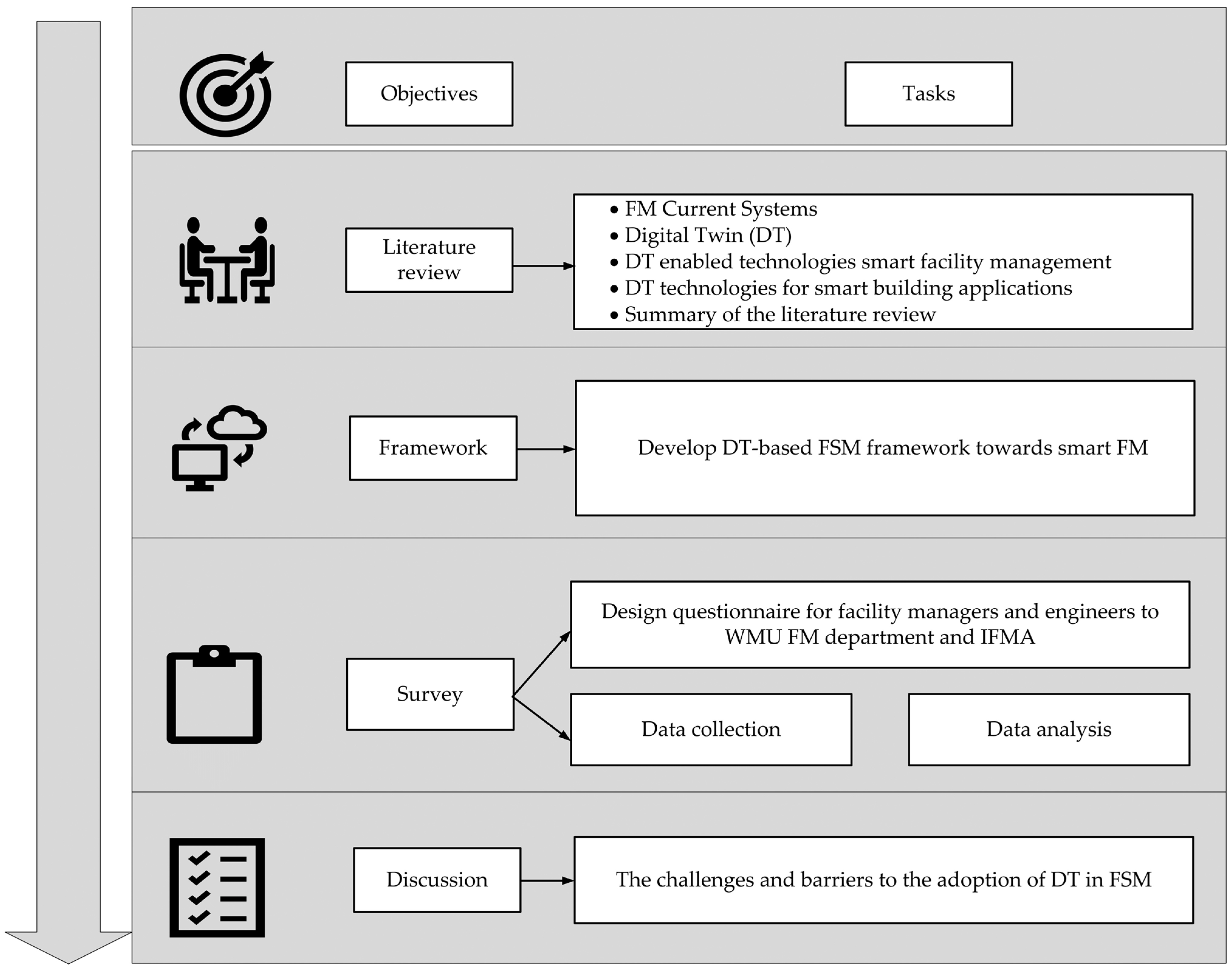
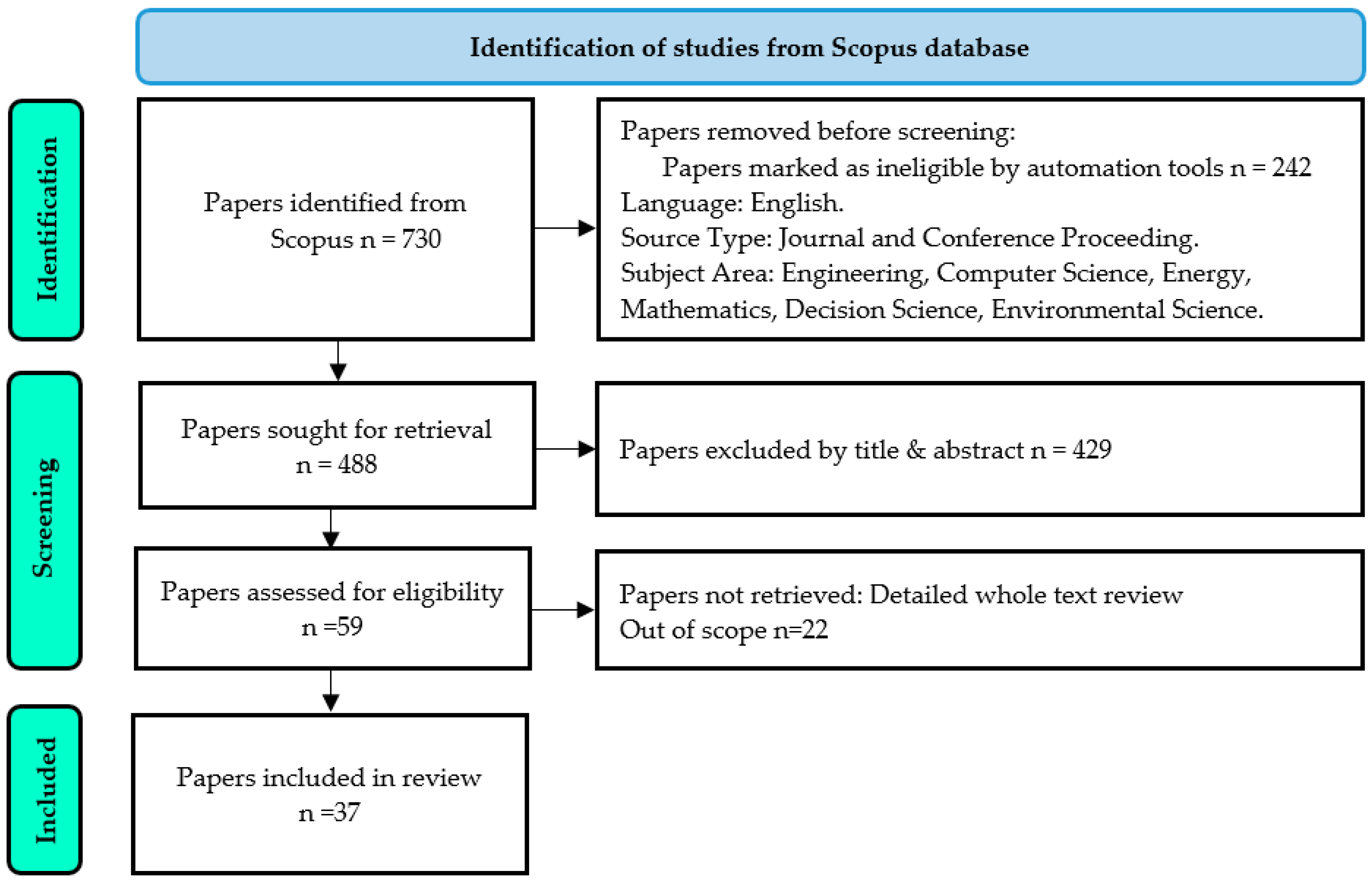
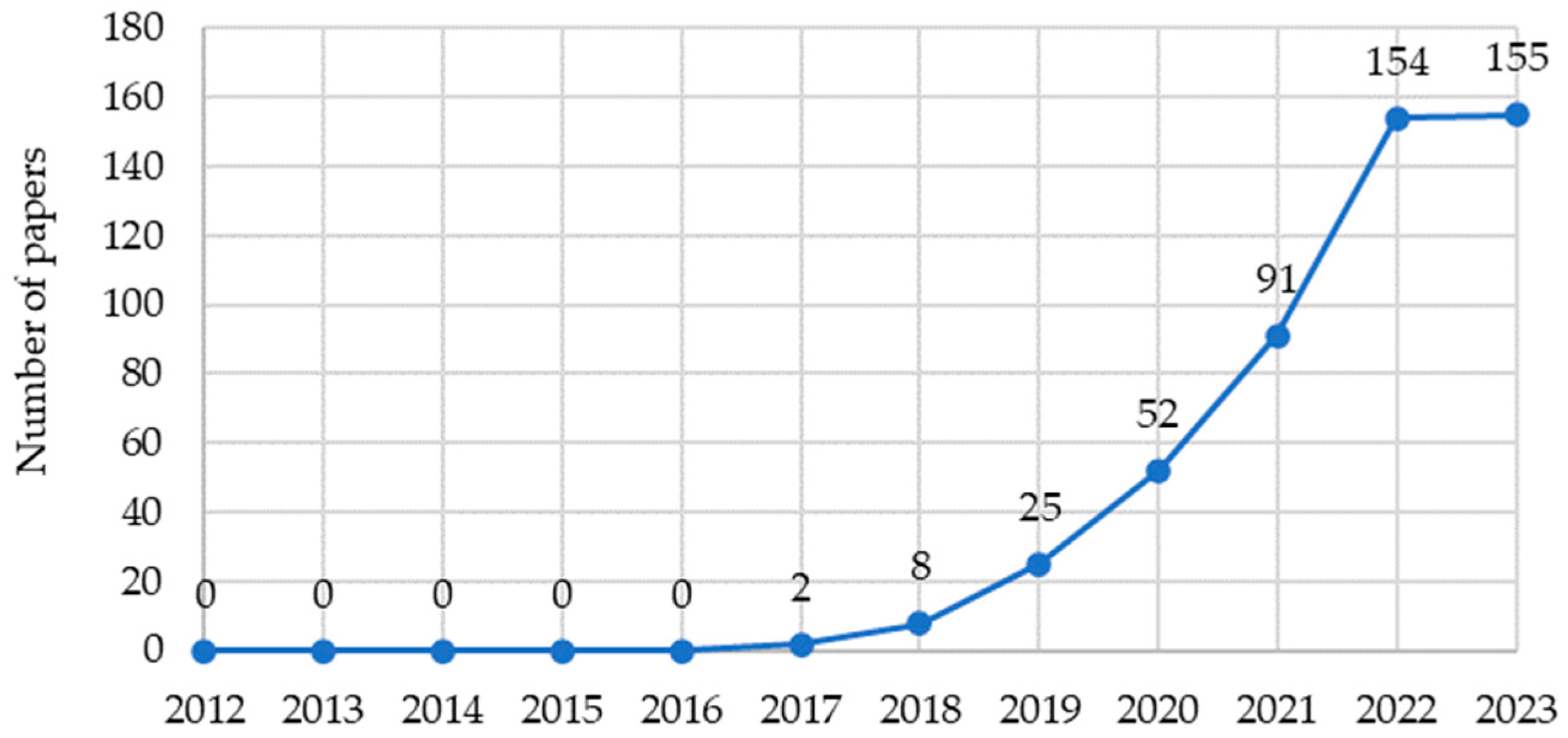

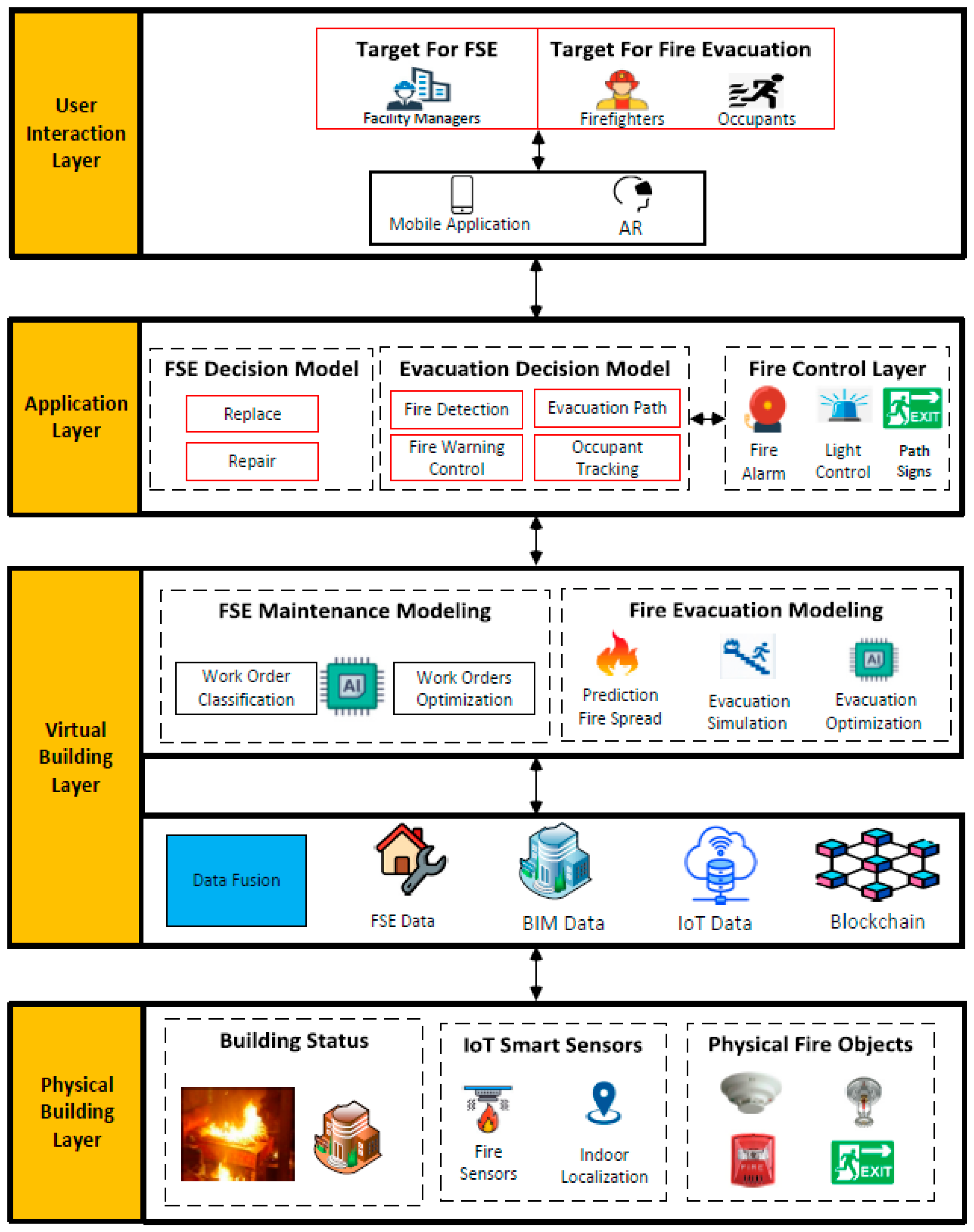
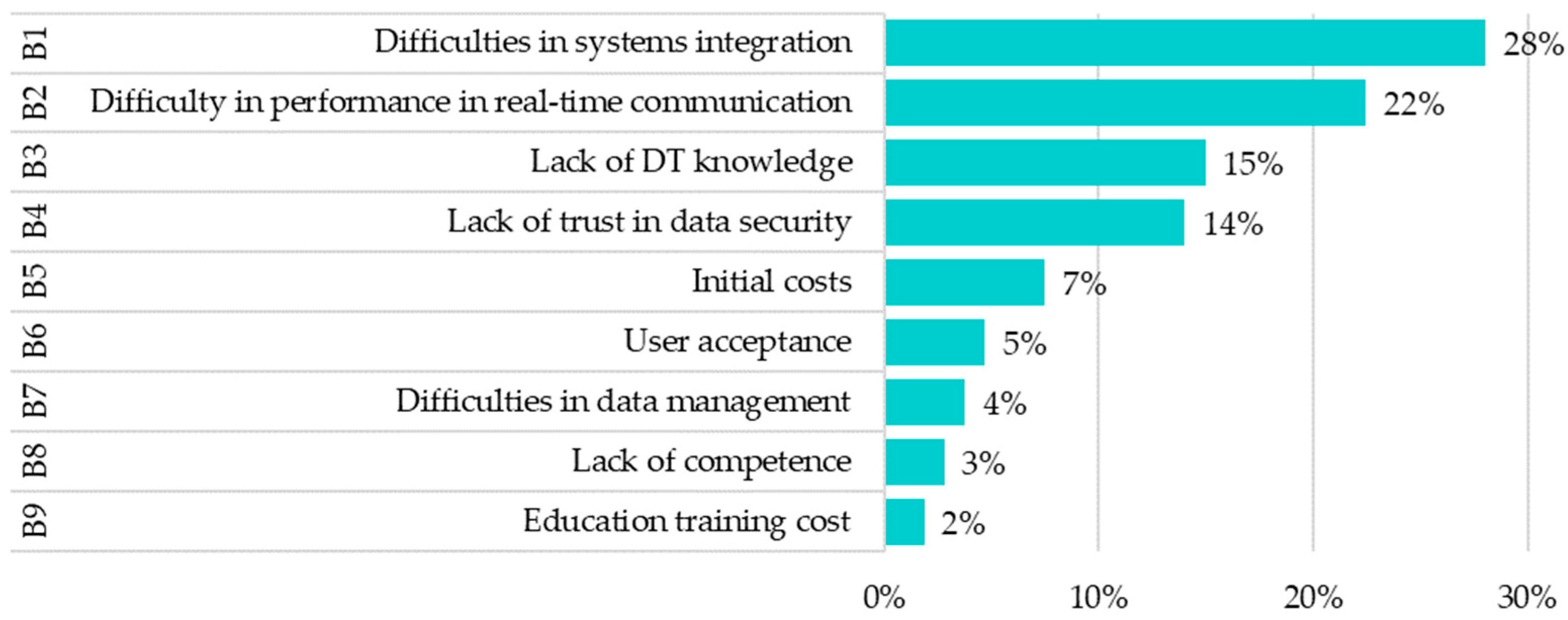



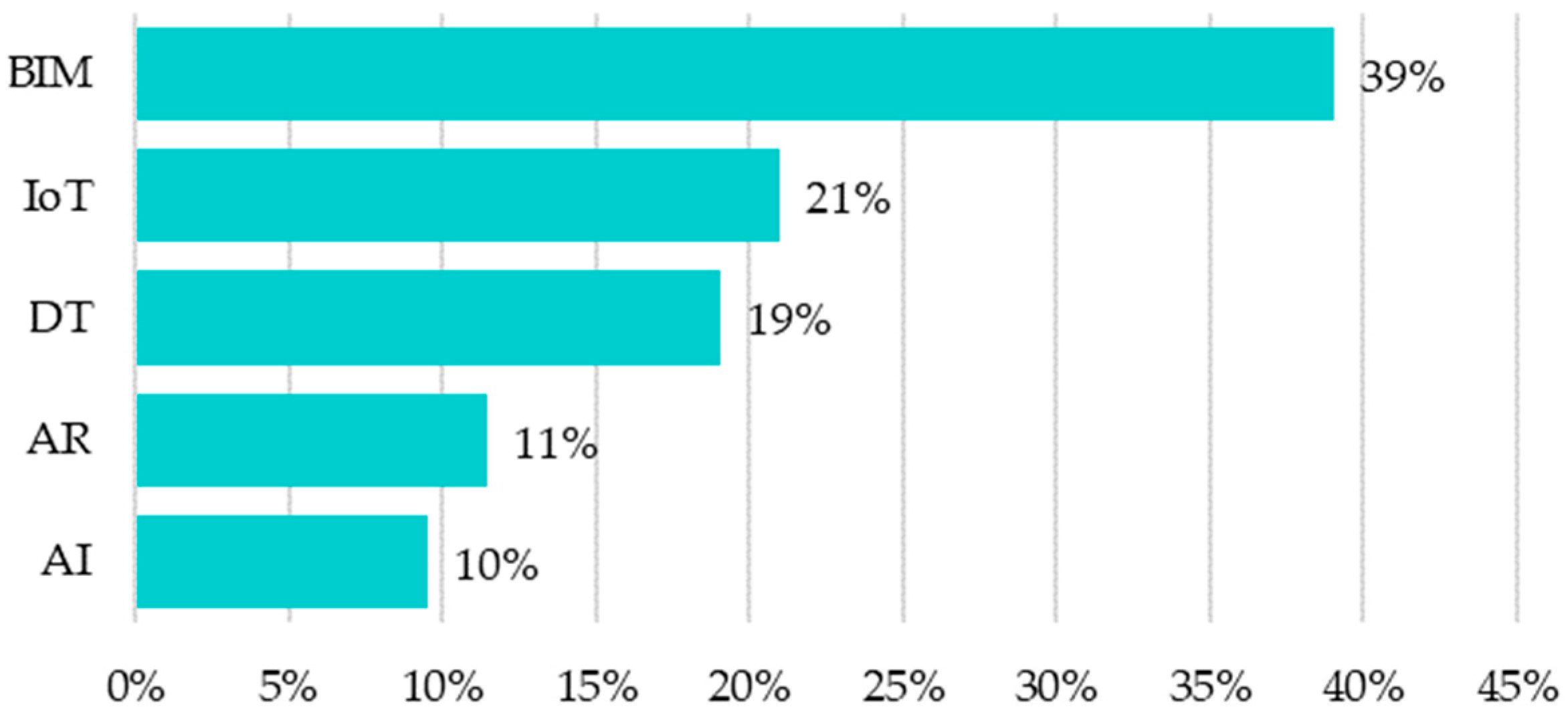
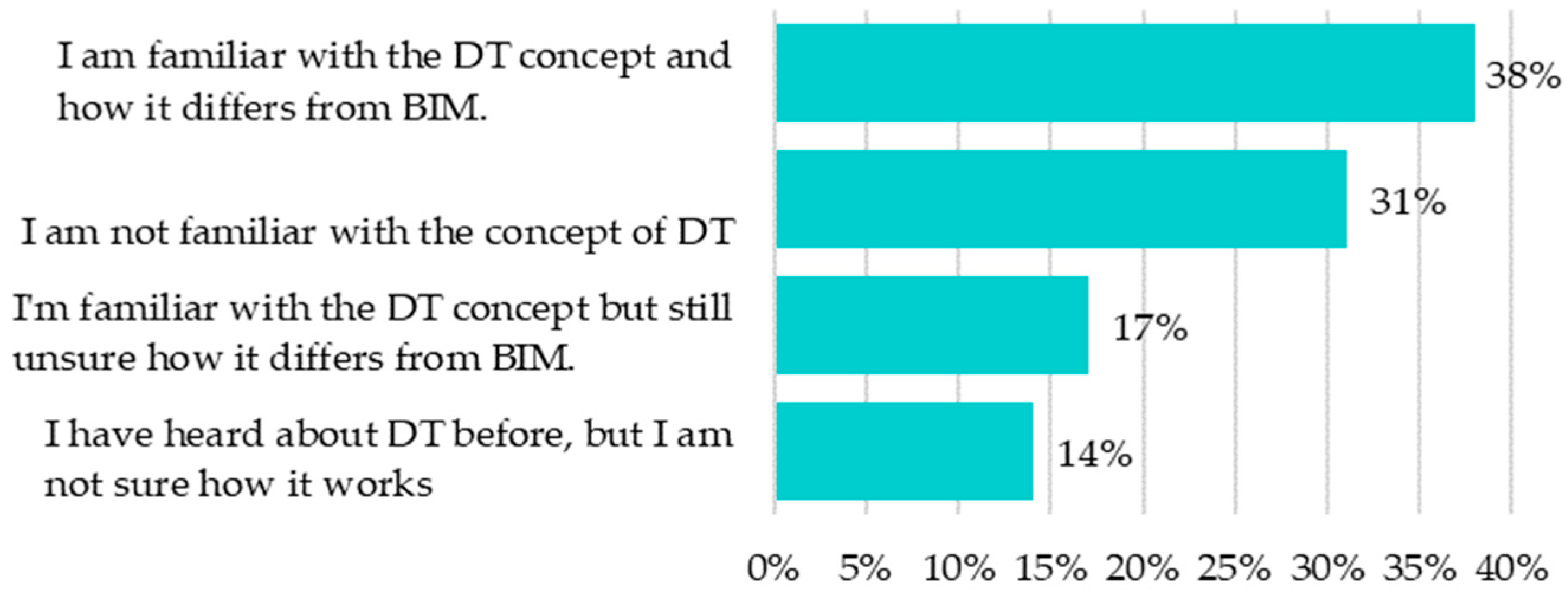
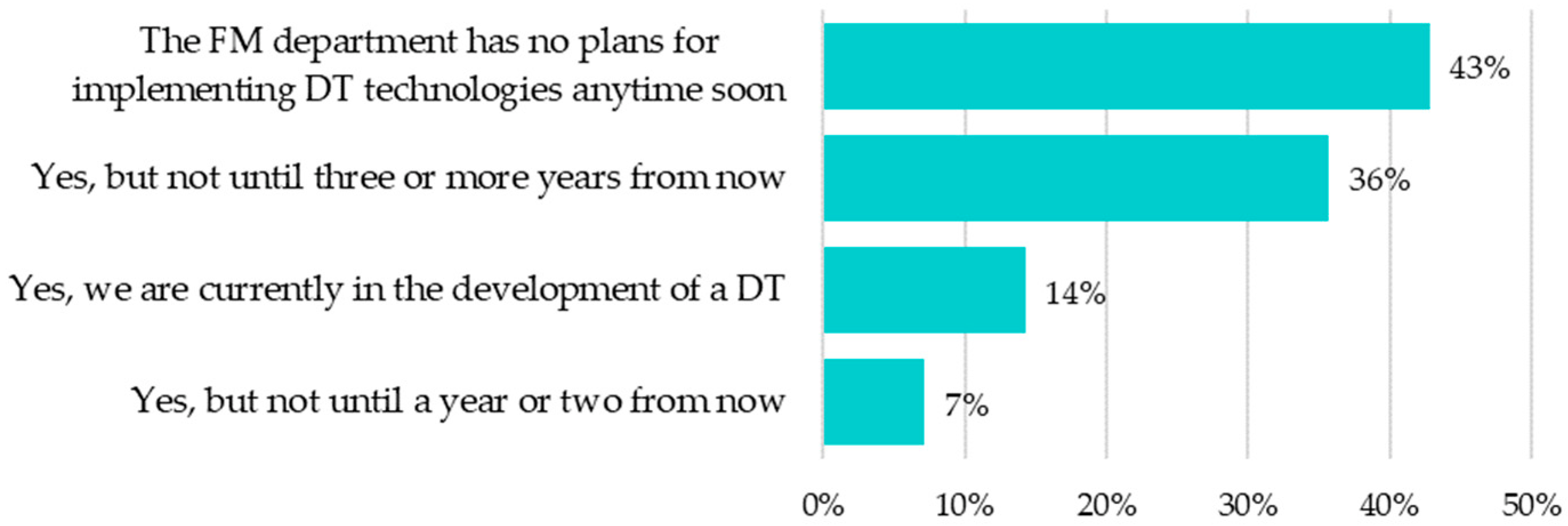
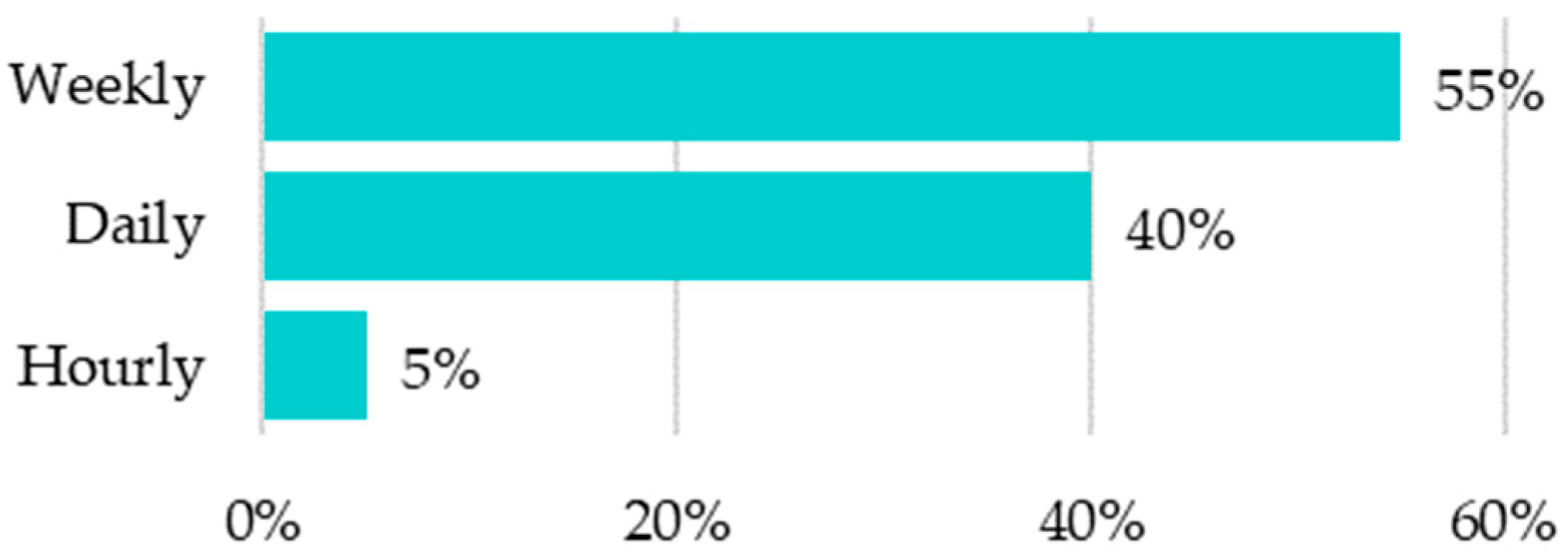
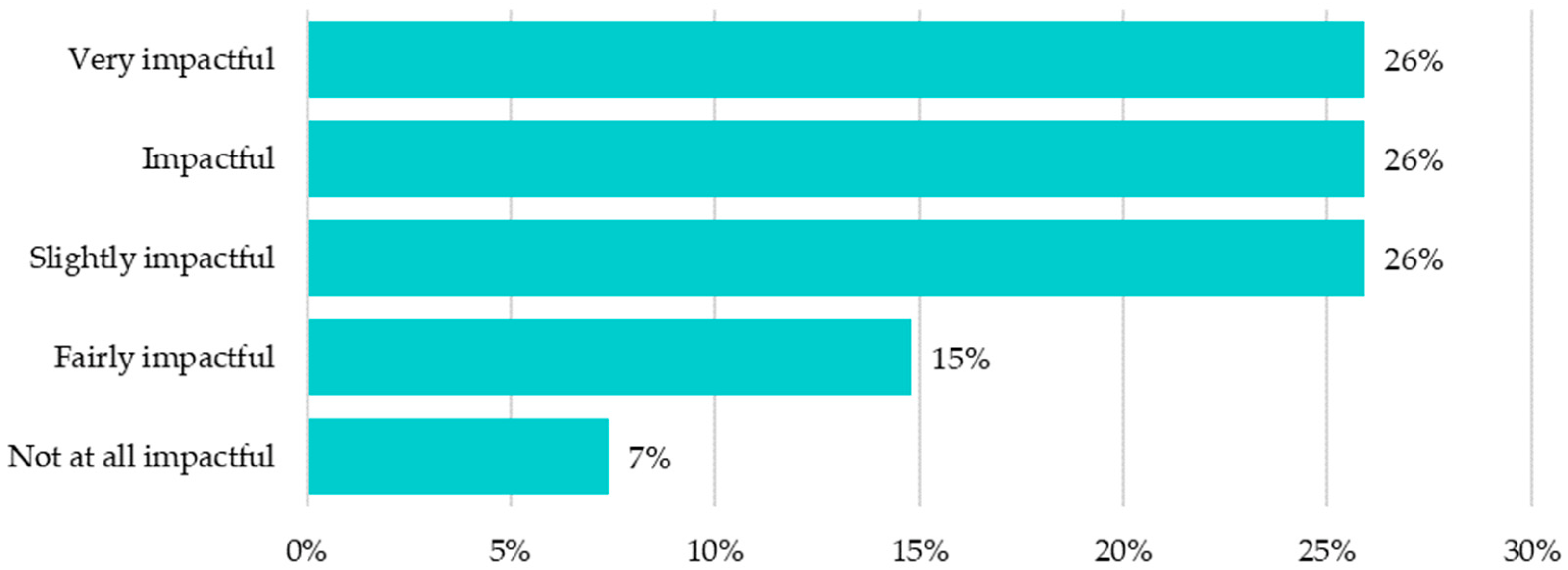
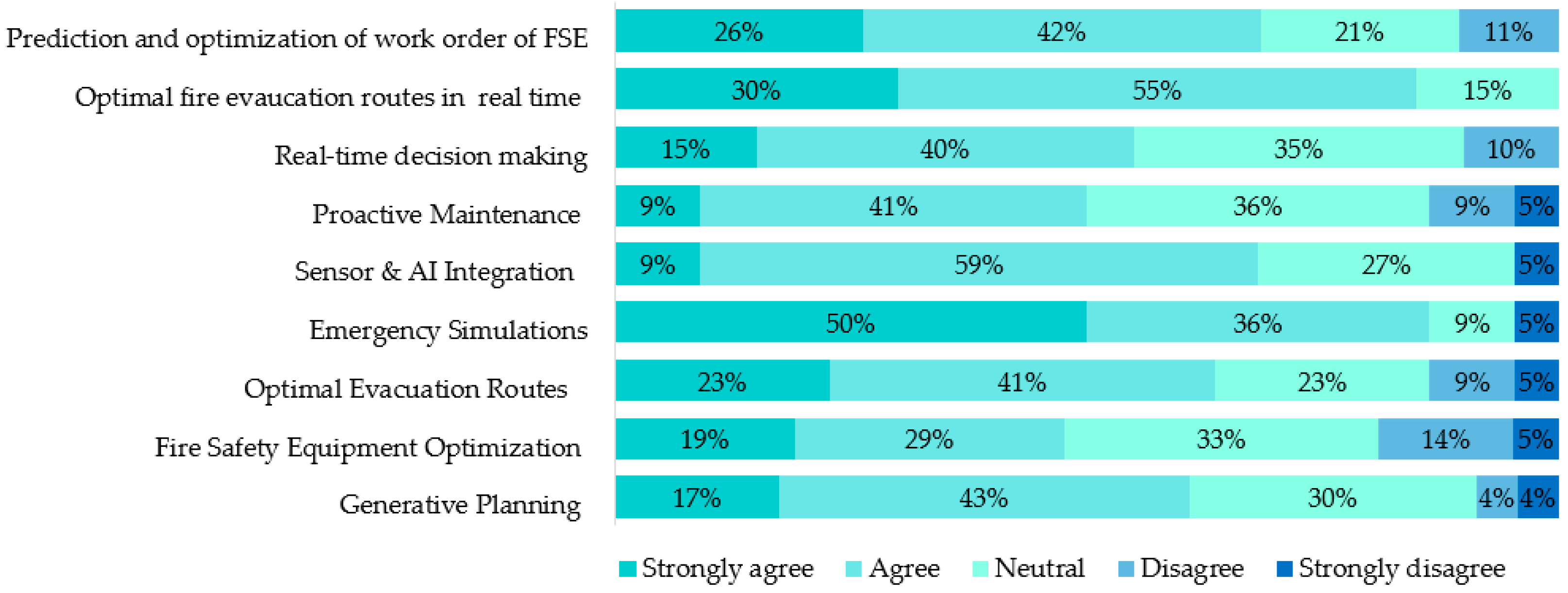
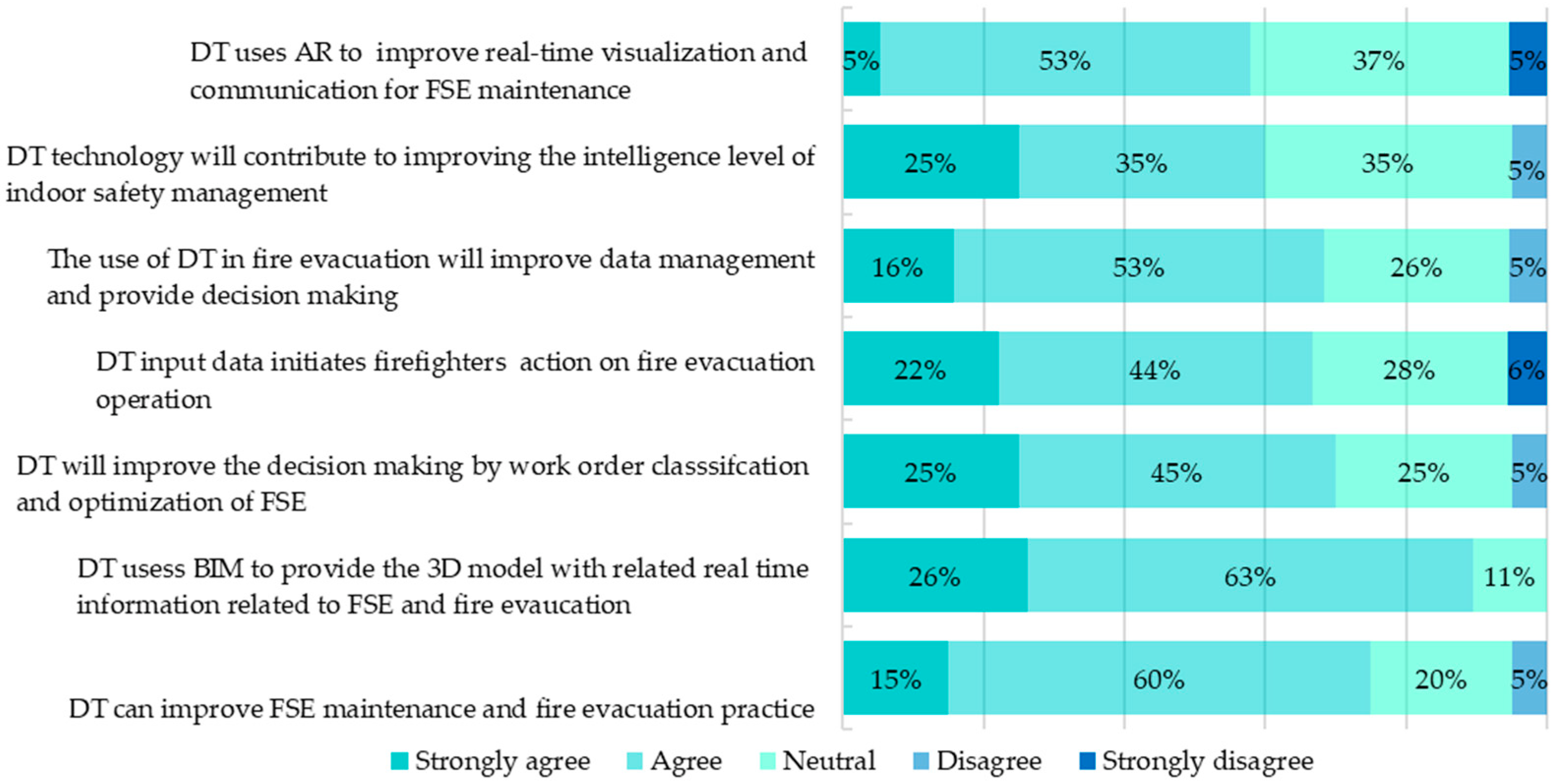


| Paper | Title | Applications | Technologies | Sector | Barriers |
|---|---|---|---|---|---|
| [21] | A framework for an indoor safety management system based on digital twin | Indoor safety management system (ISMS) using DT technology for real-time safety monitoring, danger assessments, and management within buildings. | BIM, IoT, ML | Stadium | BIM and IoT integration and independent safety management systems |
| [24] | Building artificial-intelligence digital fire (AID-Fire) system: A real-scale demonstration | The AID-Fire system’s application encompasses fire detection, firefighting strategy enhancement, evacuation guidance, risk assessments, data-driven emergency responses, and ongoing safety monitoring and maintenance. | AI, IoT, DL, CV, data fusion | University campus | Sensor reliability, AI performance, real-time processing, system integration, data preprocessing, fire dynamics complexity, user interface design, and privacy concerns |
| [48] | Developing a digital twin at building and city levels: case study of west Cambridge campus. | Collaboration, visualization, and O&M management of buildings and a city. | AI, BIM, ICTs, ML, IoT, IFC | University campus | Data integration and synchronization, big data management, and data quality. |
| [80] | Digital twin hospital buildings: an exemplary case study through continuous lifecycle integration | Develop a DT for complex infrastructures, enhance clash detection using VR/AR, optimize building energy management, and advance predictive maintenance for performance forecasting | BIM + IoT + ML + VR/AR | Hospital | Complex DT model creation, interoperability issues, data security concerns, and high amount of long-term data latency. |
| [83] | Developing a web-based BIM asset and facility management system of building digital twins. | Integrating building assets throughout its lifecycle. | BIM, Unreal Engine, web in real time. | AECO/FM | Data sharing issues and unreliable operation data. |
| [84] | Federated data modeling for built environment digital twins. | Real-time monitoring and data-driven decision tools for buildings. | IoT, robotics, AR, MR, VR, AI, BIM, IFC. | University campus | Information/process clarity, fragmented data, and interoperability |
| [85] | Toward smart-building digital twins: BIM and IoT data integration. | DTs for real-time building monitoring and visualization. | BIM, IoT | University campus | Semantic interoperability and real-time building data validation. |
| [86] | CLOI: An automated benchmark framework for generating geometric digital twins of industrial facilities. | Generate automatic as-built models from point cloud data. | Point Cloud + ML/computer vision | Industrial buildings | Limited what-if scenario analysis and slow asset updating due to extensive point cloud data preparation |
| [87] | Data-driven predictive maintenance planning framework for MEP components based on BIM and IoT using machine learning algorithms | Predictive maintenance using BIM and IoT. | BIM, IoT, ML | University campus | Algorithm selection, prediction methods, and model training. |
| [88] | A digital twin predictive maintenance framework of air handling units based on automatic fault detection and diagnostics | DT predictive maintenance framework for air handling unit (AHU) | BIM, IoT, IFC, ML, AR | University campus | Algorithm selection and prediction methods |
| [89] | Towards an occupancy-oriented digital twin for facility management: test campaign and sensors assessment | Optimization of a building’s operational stage through advanced monitoring techniques and data analytics | BIM, IoT, ML | University campus | Monitoring issue in detecting more users, network security, and reliable data storage |
| [90] | Digital twin–based health care facilities management | Developing a DT for real-time, efficient management of healthcare facility systems and equipment | BIM, IoT, ML | Healthcare facility management | Data accuracy, sensor’s reliability, user privacy integration, And high initial costs |
| [91] | Intelligent emergency digital twin system for monitoring building fire evacuation | Developed a DT system based on AI and computer vision to track evacuees in building fire. | BIM, IoT, AI, CV, YOLO | University campus | Detection accuracy in crowds and privacy issues |
| Rank Barriers | Barriers | Occurrences |
|---|---|---|
| B1 | Difficulties in systems integration | 30 |
| B2 | Difficulty in performance in real-time communication | 24 |
| B3 | Lack of DT knowledge | 16 |
| B4 | Lack of trust in data security | 15 |
| B5 | Initial costs | 8 |
| B6 | User acceptance | 5 |
| B7 | Difficulties in data management | 4 |
| B8 | Lack of competence | 3 |
| B9 | Education training costs | 2 |
| Code | Enabler | Occurrences |
|---|---|---|
| E1 | AI | 27 |
| E2 | IoT | 23 |
| E3 | BIM | 20 |
| E4 | AR/VR | 8 |
| E5 | Blockchain | 5 |
| E6 | GIS | 2 |
| Category | Barriers |
|---|---|
| Stakeholder-oriented barriers | Lack of DT knowledge Lack of competence User acceptance |
| Economic barriers | Initial costs Education training costs |
| Technical barriers | Difficulties in systems integration Difficulty in performance in real-time communication Lack of trust in data security Difficulties in data management |
Disclaimer/Publisher’s Note: The statements, opinions and data contained in all publications are solely those of the individual author(s) and contributor(s) and not of MDPI and/or the editor(s). MDPI and/or the editor(s) disclaim responsibility for any injury to people or property resulting from any ideas, methods, instructions or products referred to in the content. |
© 2023 by the authors. Licensee MDPI, Basel, Switzerland. This article is an open access article distributed under the terms and conditions of the Creative Commons Attribution (CC BY) license (https://creativecommons.org/licenses/by/4.0/).
Share and Cite
Almatared, M.; Liu, H.; Abudayyeh, O.; Hakim, O.; Sulaiman, M. Digital-Twin-Based Fire Safety Management Framework for Smart Buildings. Buildings 2024, 14, 4. https://doi.org/10.3390/buildings14010004
Almatared M, Liu H, Abudayyeh O, Hakim O, Sulaiman M. Digital-Twin-Based Fire Safety Management Framework for Smart Buildings. Buildings. 2024; 14(1):4. https://doi.org/10.3390/buildings14010004
Chicago/Turabian StyleAlmatared, Manea, Hexu Liu, Osama Abudayyeh, Obaidullah Hakim, and Mohammed Sulaiman. 2024. "Digital-Twin-Based Fire Safety Management Framework for Smart Buildings" Buildings 14, no. 1: 4. https://doi.org/10.3390/buildings14010004
APA StyleAlmatared, M., Liu, H., Abudayyeh, O., Hakim, O., & Sulaiman, M. (2024). Digital-Twin-Based Fire Safety Management Framework for Smart Buildings. Buildings, 14(1), 4. https://doi.org/10.3390/buildings14010004








